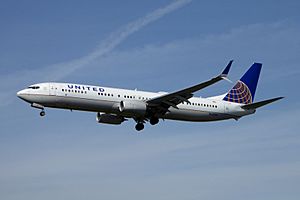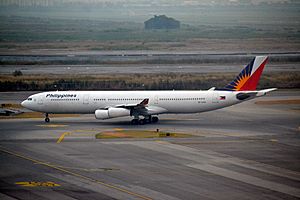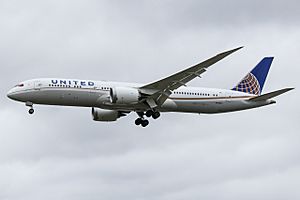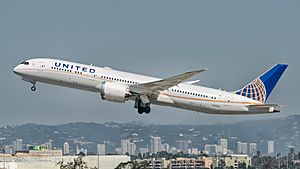Air Canada Flight 759 facts for kids
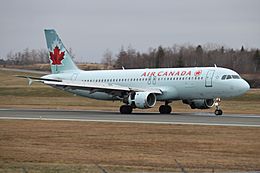
C-FKCK, the aircraft involved in the incident, in November 2019
|
|
| Incident summary | |
|---|---|
| Date | July 7, 2017 |
| Summary | Near collision on final approach |
| Place | San Francisco International Airport 37°36′58″N 122°21′34″W / 37.61611°N 122.35944°W |
| Passengers | 135 |
| Crew | 5 |
| Injuries (non-fatal) | 0 |
| Fatalities | 0 |
| Survivors | 140 |
| Aircraft type | Airbus A320-211 |
| Airline/user | Air Canada |
| Registration | C-FKCK |
| Flew from | Toronto Pearson International Airport, Mississauga, Ontario, Canada |
| Flying to | San Francisco International Airport, San Francisco, California, U.S. |
On July 7, 2017, an Airbus A320 airplane, flying as Air Canada Flight 759, almost had a serious accident at San Francisco International Airport in California, United States. The plane was coming from Toronto Pearson International Airport. Air traffic control had told the pilots to land on Runway 28R. However, the plane accidentally lined up with a parallel taxiway instead.
Four other large passenger airplanes were stopped on this taxiway, waiting to take off. They were full of fuel and passengers. Luckily, the Air Canada pilots realized their mistake just in time. They quickly pulled the plane back up into the air, avoiding a collision. This action is called a go-around. The plane then landed safely on the correct runway on its second try. The other planes on the taxiway also took off safely later.
An investigation by the National Transportation Safety Board (NTSB) found out how close the planes came. The Air Canada plane got as low as 59 feet (about 18 meters) above the ground before climbing. It missed one of the planes on the taxiway by only 14 feet (about 4 meters). The NTSB said the main reason for the near-miss was that the pilots confused the runway with the taxiway. Other factors included the pilots not using a special navigation system and being tired. This incident could have been a very serious aviation disaster, putting over 1,000 people at risk.
Contents
What Happened During the Flight?
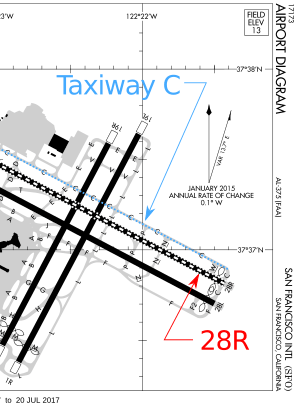
At 11:46 p.m. local time, Air Canada Flight 759 was told it could land on Runway 28R. There were 135 passengers and 5 crew members on board. Another runway, 28L, was closed that night. Its lights were off, except for a flashing "X" sign at one end.
The captain was flying the plane, and the first officer was watching the instruments. Both pilots later said they thought Runway 28R was actually Runway 28L. This made them line up for Taxiway C, which runs next to Runway 28R. Runways and taxiways have different colored lights, but the pilots still got confused. The weather was clear, so the pilots were using their eyes to guide the plane, rather than an instrument landing system (ILS).
Planes on the Taxiway
Taxiway C had four planes waiting to take off. Three were from United Airlines and one was from Philippine Airlines. At 11:55 p.m., the Air Canada pilot saw lights from other aircraft. He asked the control tower if the runway was clear. The air traffic controller replied, "There's no one on 28R but you." At this point, AC759 was very close to the runway.
The Air Canada pilots later said they didn't remember seeing planes on Taxiway C. But they felt something wasn't right. The pilots of Philippine Airlines Flight 115 turned on their landing lights. They wanted to warn AC759 that they were on the taxiway. Then, the pilot of United Airlines Flight 1, who was first in line, spoke on the radio. He asked, "Where is this guy going? He's on the taxiway."
The Go-Around Order
Right after that, at 11:56 p.m., the air traffic controller told Air Canada Flight 759 to stop its landing. This is the "go-around" order. The Air Canada pilots had already started to climb before they got the order. After they confirmed the go-around, the controller said, "It looks like you were lined up for Charlie [Taxiway C] there."
The pilot of United Airlines Flight 1 then told the tower, "Air Canada flew directly over us." The controller agreed, saying, "Yeah, I saw that, guys." During this first approach, AC759 flew for about a quarter-mile over Taxiway C. It got as low as 81 feet (about 25 meters) above the ground. It came within 29 feet (about 9 meters) sideways of the waiting planes.
According to the plane's flight data recorder, the pilots increased engine power when they were 85 feet (about 26 meters) up. The plane then dropped to 59 feet (about 18 meters) before climbing. Experts later said that if the crew had waited just five more seconds to pull up, they would have hit one of the planes on the taxiway. There was also less than 14 feet (about 4 meters) of space between the bottom of the Air Canada plane and the tail of a Philippine Airlines Airbus A340.
Airport Systems and Control
San Francisco International Airport has a system called Airport Surface Surveillance Capability (ASSC). This system should warn controllers about possible conflicts between planes on runways and taxiways. However, AC759 disappeared from the controller's ASSC screen for 12 seconds. This happened because AC759 was too far off course from Runway 28R.
After the go-around, Air Canada Flight 759 made a second approach. It landed safely without any problems. At the time of the incident, only one air traffic controller was managing both ground and tower radio frequencies. Usually, two controllers handle these tasks.
Aircraft Involved
The plane flying Air Canada Flight 759 that night was an Airbus A320-200, with the registration C-FKCK. It was 24.5 years old.
| Airline | Flight # | Aircraft | Capacity | Registration | Origin | Destination |
|---|---|---|---|---|---|---|
| Air Canada | ACA 759 | Airbus A320-200 | 146 | C-FKCK | Toronto | San Francisco |
| United Airlines | UAL 1 | Boeing 787-9 | 252 | N29961 | San Francisco | Singapore |
| Philippine Airlines | PAL 115 | Airbus A340-300 | 254 | RP-C3441 | Manila | |
| United Airlines | UAL 863 | Boeing 787-9 | 252 | N13954 | Sydney | |
| United Airlines | UAL 1118 | Boeing 737-900ER | 179 | N62895 | Cancún |
Investigation into the Near-Miss
The National Transportation Safety Board (NTSB) in the United States led the investigation into this incident. They got help from the Federal Aviation Administration (FAA). The Transportation Safety Board of Canada (TSB) also helped by sharing information from Air Canada.
Some pilots mentioned that landing at SFO needs "precision flying." This is because the two main runways (28R and 28L) are only about 750 feet (229 meters) apart. Taxiway C is even closer to Runway 28R, less than 500 feet (152 meters) away. Other pilots said that some airlines require pilots to use the instrument landing system (ILS) for every landing. This system would have shown the pilots they were not lined up with the correct runway.
Key Findings of the Investigation
The NTSB released its final report in September 2018. They said the most likely cause was the pilots confusing Taxiway C for Runway 28R. This happened partly because they missed information about Runway 28L being closed.
Other factors that contributed to the incident included:
- The pilots did not use the instrument landing system (ILS).
- The pilots were tired. The first officer had not rested much for 12 hours. The captain had been awake for 19 hours. This meant he would not have been allowed to fly under US pilot fatigue rules.
Changes and Recommendations
After the incident, Transport Canada planned to update its pilot rest rules to match international standards. New rules were announced in December 2018.
The Federal Aviation Administration (FAA) received several recommendations to improve safety. These included:
- Making sure pilots are clearly warned when they are not lined up with a runway, especially in busy airspace.
- Improving how important flight information (called NOTAMs) is given to pilots.
- Changing airports to better warn about collision risks and clearly show closed runways.
Air Canada also made changes. They simplified their landing charts for SFO. They added specific training for SFO landings in flight simulators. They also started training staff to reduce "expectation bias," which is when people see what they expect to see instead of what is actually there.
The NTSB also suggested that airlines should report incidents faster. This is because the cockpit voice recording from AC759 was recorded over before the investigation started. This happened because the plane flew three more flights before the NTSB was told about the near-miss. The NTSB wants to capture more recording time, increasing it from two hours to 25 hours.
Aftermath and Safety Improvements
Following the incident, in early August, the Federal Aviation Administration changed nighttime landing rules at SFO. They stopped allowing pilots to land using only their eyes ("visual approaches") at night when a parallel runway is closed. Instead, pilots must use instrument systems. They also required two air traffic controllers in the control tower during busy late-night arrival times.
Air Canada temporarily stopped using flight number 759. However, they have since started using it again for flights from Montreal to San Francisco.
See also
 In Spanish: Vuelo 759 de Air Canada para niños
In Spanish: Vuelo 759 de Air Canada para niños


